Confederate Cemetery in Ohio
While I was attending other business, I just happened to come upon a Confederate Cemetery in Columbus Ohio. I never knew that this place existed, especially in such an unlikely place in the middle of a large metropolis in the North. I doubt whether the locals even know of it’s existence, or the history behind this graveyard.
The area where the cemetery is presently located was a training camp for Ohio Soldiers during the Civil War. Called Camp Chase, it also served as a parole camp, a muster-out post, and a place of confinement for confederate prisoners-of-war. As many as a 150,000 Union soldiers and 25,000 Confederate prisoners once lived here from 1861-1865. And where more than 2,000 Confederates died and are currently buried in the existing cemetery. Some of the Confederates prisoners that were interned here were participants in Morgan’s Raid, a diversionary incursion by Confederate cavalry into the Union states of Indiana, Kentucky, Ohio and West Virginia. More than likely they were probably captured after the Battle of Buffington Island in 1863, the largest battle in Ohio during the Civil War and a future subject for a painting I plan on doing.
 You would expect a cemetery containing the graves of enemy soldiers of a war that was fought over 150 years ago would look run down and unkept, but it is quite the opposite. For the most part, the headstones look clean and fresh, arranged in neat rows. The grass is cut short and well maintained. The look is quite similar to other military cemeteries containing the graves of fallen soldiers of more recent wars. In the middle of the cemetery sits a large boulder, over which is built a stone arch topped with a statue of a Confederate soldier. Inscribed in the boulder it is written “2260 Confederate soldiers of the war 1861 – 1865 buried in this enclosure.” In the stone arch above is inscribed the words “Americans”. A reminder that all of the fallen warriors, blue and gray, are americans.
You would expect a cemetery containing the graves of enemy soldiers of a war that was fought over 150 years ago would look run down and unkept, but it is quite the opposite. For the most part, the headstones look clean and fresh, arranged in neat rows. The grass is cut short and well maintained. The look is quite similar to other military cemeteries containing the graves of fallen soldiers of more recent wars. In the middle of the cemetery sits a large boulder, over which is built a stone arch topped with a statue of a Confederate soldier. Inscribed in the boulder it is written “2260 Confederate soldiers of the war 1861 – 1865 buried in this enclosure.” In the stone arch above is inscribed the words “Americans”. A reminder that all of the fallen warriors, blue and gray, are americans.
There are also other features that are in the cemetery. There is a small plaque topped with a cannonball from the Battle of Vicksburg. A roadside marker just outside the front gate along Sullivant Ave. gives a brief description and history of Camp Chase. 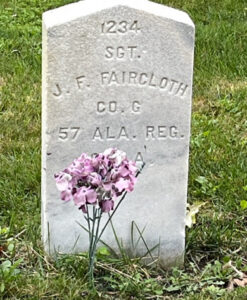 Inside the walls of the cemetery is a an interpretive marker with photos giving a more detailed description of the site. Since my time there was limited, this is all I saw giving the time I had, so there may be other points of interest at the cemetery. I have read that interpretive sign in front of the Westgate Masonic Temple at 2925 West Broad Street, which is not far away, sits at the site of the main entrance to the Camp. But there was one sight that particularly got my attention. Placed on the grave of a sergeant was a fresh set of flowers. That someone had the time to place this on the grave of a soldier from Alabama buried so far away in the middle of Ohio reminds all of us that the sacrifice that these men made over 150 years is not forgotten.
Inside the walls of the cemetery is a an interpretive marker with photos giving a more detailed description of the site. Since my time there was limited, this is all I saw giving the time I had, so there may be other points of interest at the cemetery. I have read that interpretive sign in front of the Westgate Masonic Temple at 2925 West Broad Street, which is not far away, sits at the site of the main entrance to the Camp. But there was one sight that particularly got my attention. Placed on the grave of a sergeant was a fresh set of flowers. That someone had the time to place this on the grave of a soldier from Alabama buried so far away in the middle of Ohio reminds all of us that the sacrifice that these men made over 150 years is not forgotten.
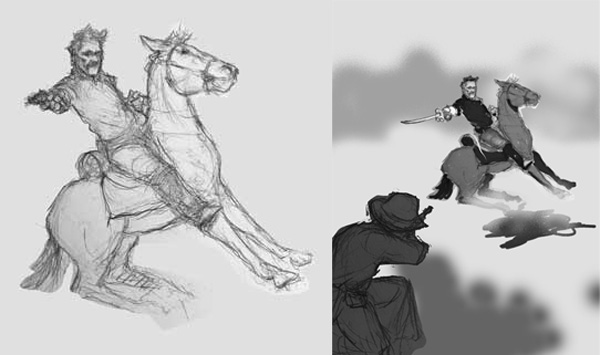
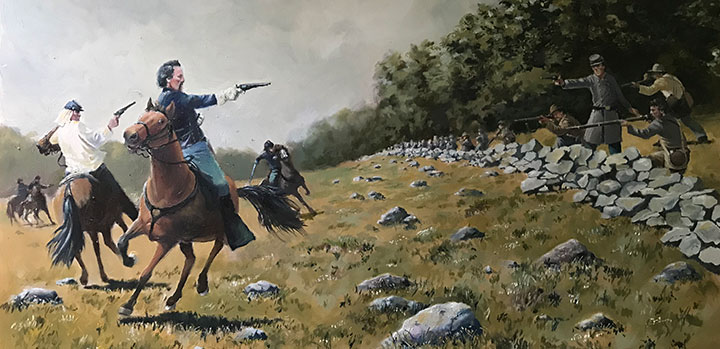
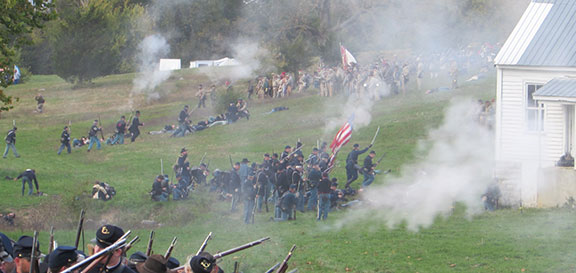
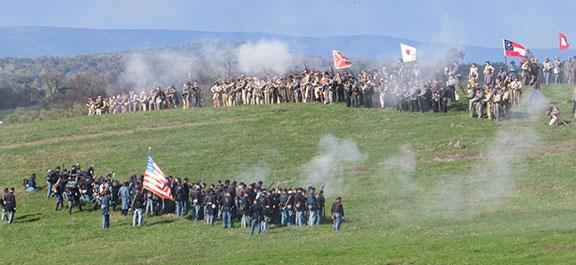
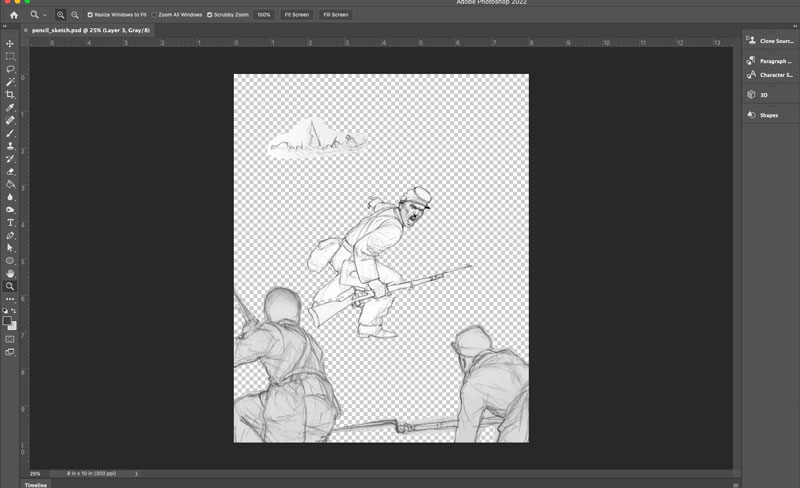


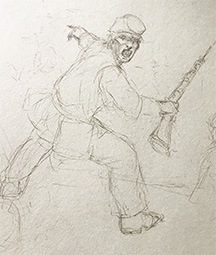 Just like all art, the hardest thing about painting of the Battle of Chaffin’s Farm is how to illustrate the scene. The challenge is not only show Pinn leading his men, but to also show the landscape and the Confederate defenses. This presents quite a challenge. I decided that having the viewpoint of one of the Pinn’s soldier is the answer. The painting would depict Pinn turning towards the viewer as if he was urging you on to press the attack. At the same time, he is pointing towards the objective, the enemy defenses. I have included a very rough sketch of how I would pose Pinn in the painting.
Just like all art, the hardest thing about painting of the Battle of Chaffin’s Farm is how to illustrate the scene. The challenge is not only show Pinn leading his men, but to also show the landscape and the Confederate defenses. This presents quite a challenge. I decided that having the viewpoint of one of the Pinn’s soldier is the answer. The painting would depict Pinn turning towards the viewer as if he was urging you on to press the attack. At the same time, he is pointing towards the objective, the enemy defenses. I have included a very rough sketch of how I would pose Pinn in the painting.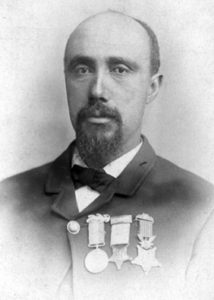 To learn more about the life of Robert Pinn and his accomplishments during and after the war, visit the
To learn more about the life of Robert Pinn and his accomplishments during and after the war, visit the 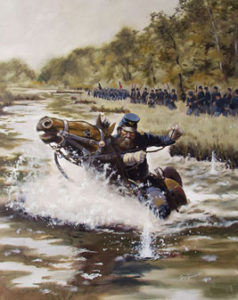 I have already completed one oil civil war painting with a subject that is Ohio related.
I have already completed one oil civil war painting with a subject that is Ohio related. 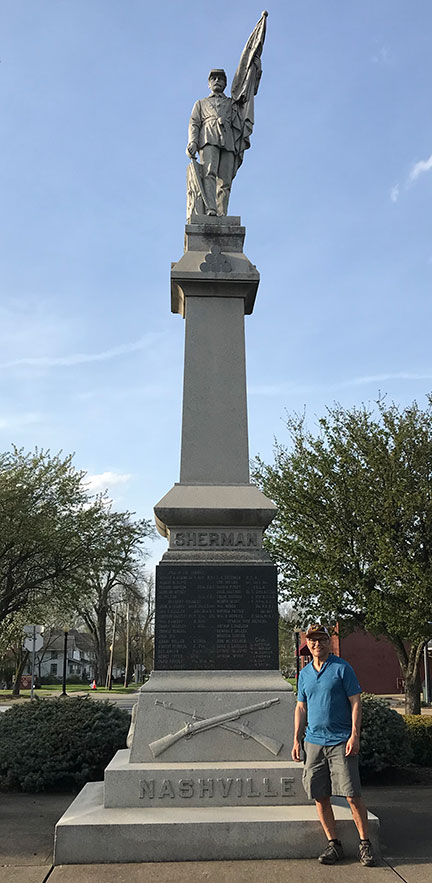 Just this last weekend, as my wife and I visited my son and his fiance in their new house, we passed through a small town name La Grange, where there stands a large Civil War monument dedicated to soldiers of the nearby area who served in wars before 1903. On the way back home, we stopped so I could have my picture taken, and view the monument more closely.
Just this last weekend, as my wife and I visited my son and his fiance in their new house, we passed through a small town name La Grange, where there stands a large Civil War monument dedicated to soldiers of the nearby area who served in wars before 1903. On the way back home, we stopped so I could have my picture taken, and view the monument more closely.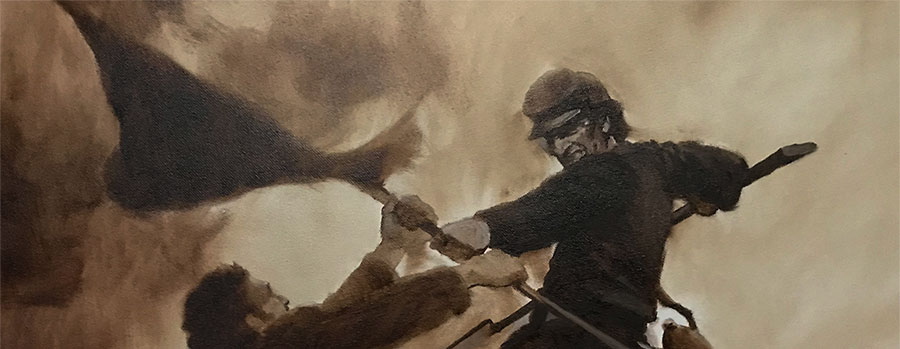 Medal of Honor for capturing the enemy flag
Medal of Honor for capturing the enemy flag